
A study on the Traditional Agricultural Tools and Skills of the Angami Nagas
Vikeyienuo Rutsa 1![]()
1 Assistant
Professor, Department of Tenyidie, Oriental College,
Kohima, Nagaland, India
|
|
ABSTRACT |
||
|
Since time immemorial, our forefathers have had the knowledge and skills to create and craft a variety of implements and tools to assist themselves in all the different work they did for survival. With their indigenous knowledge, they crafted different tools for different work at different seasons. Traditional agricultural tools were made up of locally available materials like bamboo, wood etc. Agriculture, being the primary and most important occupation of the Angami Naga, our forefathers grew and cultivated their own crops. From the richest to the poorest, all Angami folks owned their own plot of land and fields and maintain self-sufficiency. Survival was never a problem for them, which is why the need to import food from outside never arose, nor was there any worry about shortage of food. The ingenuity and innate intelligence to work efficiently and earn one’s livelihood is, thus, very clear. This study is
undertaken to identify various traditional tools used for agricultural
purposes by the farmers and also to explore the surviving skills of the
Angami community. The research is conducted mostly in and around Kohima
village which is considered as the second largest village in the Asian
Continent. The fieldwork is documented through interviews and discussions.
The study is descriptive in nature. It is intended that this paper may raise
interest and inspire more in-depth research in the field. |
|||
|
Received 04 November
2024 Accepted 20 December 2024 Published 31 December 2024 Corresponding Author Vikeyienuo Rutsa, vikeyienuo.rutsa@gmail.com DOI 10.29121/granthaalayah.v12.i12SE.2024.5898 Funding: This research
received no specific grant from any funding agency in the public, commercial,
or not-for-profit sectors. Copyright: © 2024 The
Author(s). This work is licensed under a Creative Commons
Attribution 4.0 International License. With the
license CC-BY, authors retain the copyright, allowing anyone to download,
reuse, re-print, modify, distribute, and/or copy their contribution. The work
must be properly attributed to its author.
|
|||
|
Keywords: Traditional, Agricultural, Tools,
Forefathers, Angami-Naga, Survival |
|||
1. INTRODUCTION
The Angami tribe is one of the major tribes of the Nagas,
and the Nagas are a group of tribes living in the state of Nagaland, adjacent
to neighbouring states, Assam and Manipur, and neighbouring country Myanmar.
The Angamis inhabit the whole of Kohima district and minor parts of Dimapur
district, Chümoukedima district, and Niuland district, comprising of 90 villages approximately.
According to the 2011 census, the population of the Angamis stands at 141,722
approximately. With the coming of the British, the Angami areas were divided
into four regions for administrative purposes i.e. Northern, Southern, Western,
and Chakhro region. Thus, at present, it is
common to identify the Angami region based on the geographic distribution.
Agriculture is the primary occupation of the Angami Nagas. To achieve self-sufficiency and maintain survival, Angami farmers have been crafting and using a variety of tools in their agricultural operations and for household purposes. Except for iron, the tools were crafted using locally available materials, and the repairing and maintenance were also done by themselves. The indigenous knowledge possessed by them is quite admirable, and can be utilised as a base for modern tools.
2. Objective
1) 1.To identify the traditional agricultural tools and their purposes.
2) 2.To study the survival mode of the Angami community.
3. Methodology
The methodology applied for conducting the study is mostly based on primary sources. The fieldwork was conducted in and around Kohima Village, Kohima, Nagaland. The research approach is carried out qualitatively through primary sources of interview with farmers, elderly people, and retired government officials in concerned departments. Secondary sources are collected from books.
4. Findings
Tilling tools
Tilling is the most basic operation in farming or
cultivation. It is done to prepare the soil for seeds and plants to grow
favourably. Usually, Angami farmers till their lands manually. Because this
requires a lot of time and energy, they used spade (kejü)
for tilling purposes. It is found that generally, the Angami farmers used three
types of indigenous spades for different work at different seasons.
1) Jütho: This spade is used to till dry lands/soil. The basic components of jütho are an iron blade, a wooden handle, and rope. The handle is 50-60 cm long with a U- shaped curved head Figure 1. The iron blade is fitted to the U-shaped, curved head and tied up with rope which is made of bamboo strips. Angami folks used this spade for gardening and jhum cultivation.
Figure 1
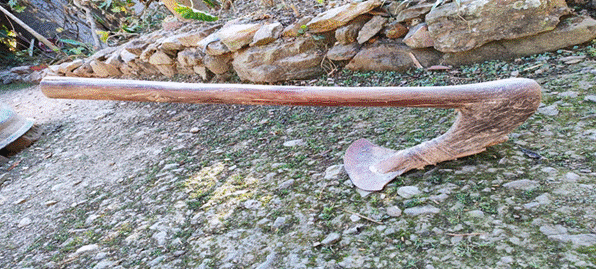
|
Figure 1 Jütho |
2) Khunuojü: This spade is specifically used in paddy field. The composition of this spade is the same as jütho, except for the iron blade, which is bigger in size (Figure 2). Rice being the staple food of the Angami Naga, they depend largely on agriculture, especially paddy field. As such, khunuojü is crafted in such a way as to cater to the needs of the work. This particular, specialized tool is designed for use during the monsoon season, to carefully level the mud and ensure even distribution of water, thus preparing the paddy field for transplanting rice saplings. For the Angami folks, this starts from month of May and lasts till July.
Figure 2
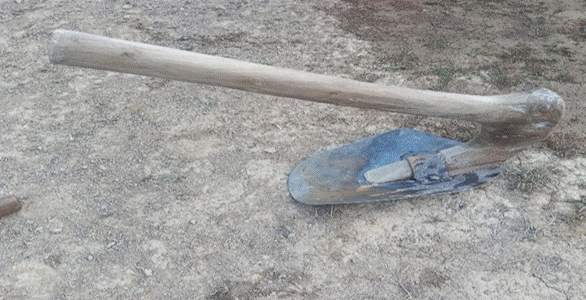
|
Figure 2 Khunuojü |
3) Dithojü: This spade is smaller than jütho and khunuojü and can be used single handed. Unlike the other two, it has a small blade of 3-inch edge, blade length of 12-15 cm, and a wooden handle of 30 cm (Figure 3). This spade is used especially in jhum cultivation and gardening, to clean the weeds in between the plants and to loosen the soil around it to promote its growth.
Figure 3

|
Figure 3 Dithojü |
Rake (charuo): This agricultural tool is used for various purposes. It is made of bamboo. It has a tooth-like bar with a handle of 70-90cm long (Figure 4). It is used to level the soil and create a smooth surface for planting. It also smoothen the soil by removing debris and unwanted weeds. It is a handy tool in gardens as well as Jhum fields.
Figure 4

|
Figure 4 Charuo |
Machete (Zhie): Zhie is an essential tool and is popularly used by the Angami Naga. It has a long, flat iron blade measuring 30-40 cm with a one side edge and is attached to a wooden handle measuring 20-30 cm (Figure 5). This tool is used for cultivation purposes as well as household works. Zhie was also used by our forefathers as a means of self-defence.
Figure 5
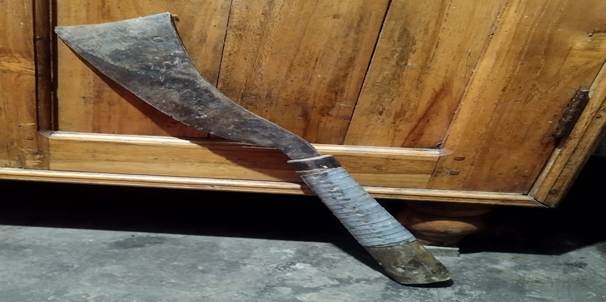
|
Figure 5 Zhie |
Harvesting tools
Harvesting marks the final stage of crop cultivation. Harvesting takes place from September to November. Some of the tools used in harvesting are identified below.
1) Sickle (Zhiefinuo): This tool is used in harvesting rice and millets. Zhiefinuo is a single hand-held, c-shaped iron blade with sharp teeth and a short wooden handle (Figure 6).
Figure 6
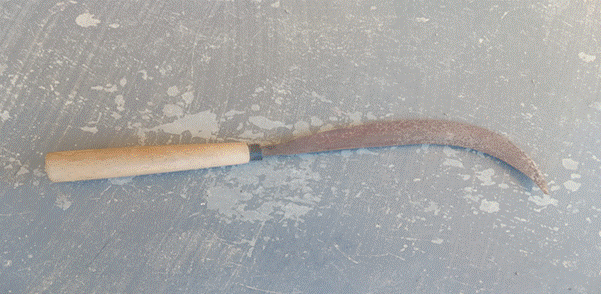
|
Figure 6 Zhiefinuo |
2) Carrying basket (Mekho): Mekho is used for carrying grains and other items. It is woven with bamboo strips. It also has a head strap which is also made of bamboo strips. This basket is carried on the head (Figure 7).
Figure 7
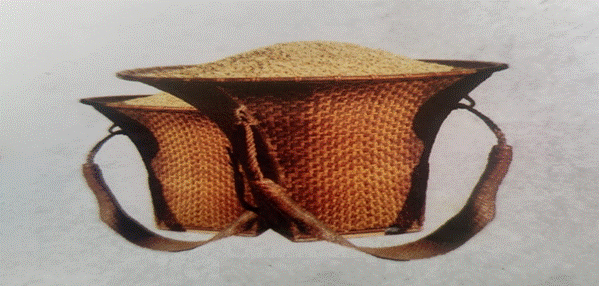
|
Figure 7 Mekho |
3) Zoprie & Lhavasi: Zoprie is a bamboo mat used during harvesting to thresh the grains. It is also used as a drying mat to dry grains. It is woven with bamboo strips. Lhavasi is a rake made of wood, used to spread and level the grains while drying. It has a tooth bar with a 2m long handle (Figure 8).
Figure 8
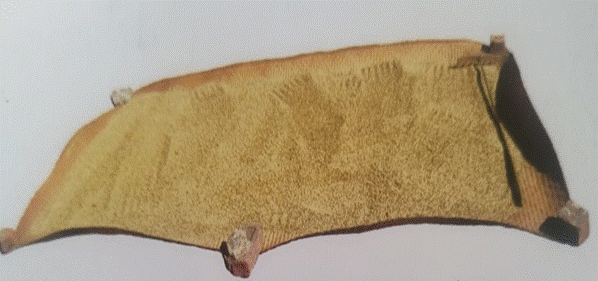
|
Figure 8 Zoprie & Lhavasei |
4) Winnower (Lieherü/zharü): These tools are used for cleaning and winnowing grains. It is woven with bamboo strips and sometimes coated with a thin layer of cow dung to fill the gaps in between the strips. (Figure 9).
Figure 9
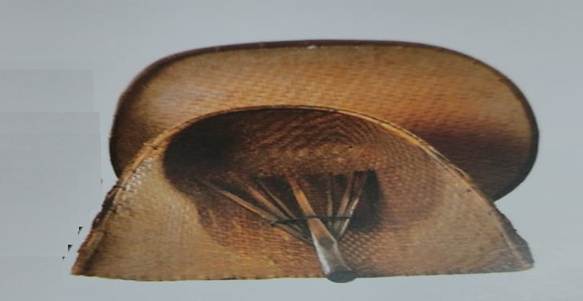
|
Figure 9 Zharü & Lieherü |
Storing tools/methods
The forefathers in the past used various creative methods to store their grains, seeds and valuable commodities. These storage containers were mostly made from locally available materials like wood, bamboo, and cane. This traditional method of storage, not only provide a safe and secure way of storing grains and valuables, but it also reflects the ingenuity of our forefathers. Below are some traditional storage items.
1) Granaries (Chü): Chü is the traditional grain storage of the Angami Naga. It is a sturdy structure woven with bamboo strips and designed to store large quantities of grains. They are designed to protect grains from moisture, pests, and rodents. An average measurement of chü is - height 5 feet, base breadth 4 feet, opening end diameter 2.5 feet, central body cylindrical shape having 5 feet diameter, and a conical shaped lid having a height of 2 feet (Figure 10).
Figure 10
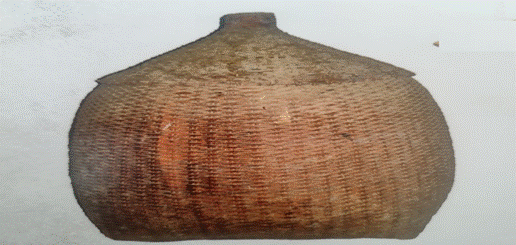
|
Figure 10 Chü |
2) Earthen pots and vessels (Litho/Liki): These containers are made of clay and are used for cooking purposes as well as storing valuables and brews (Figure 11).
Figure 11
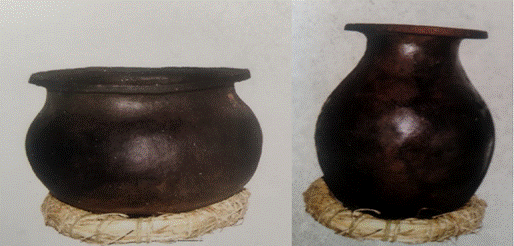
|
Figure 11 Litho & Liki |
3) Tsiachünuo: Tsiachünuo is a bamboo woven basket for storing grains and seeds. It has a lid to protect the seeds from pests and rodents (Figure 12).
Figure 12
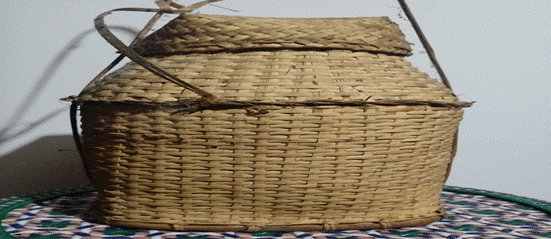
|
Figure 12 Tsiachünuo |
5. Fermenting/brewing tools
Traditional brewing tools have been in use since time immemorial by the Angamis, to produce a variety of beverages. Some of the fermented brews are rice brew, millet brew and Job’s tears brew. Here are some traditional brewing tools.
1) Zutse: This is a container used for fermenting beverages and also for storing brews as well. It is chiselled out from tree trunk and has a diameter of 50-70 cm and length of 90-100 cm (Figure 13). Zutse has a lifespan of hundreds of years and is thus, passed down through generations.
Figure 13
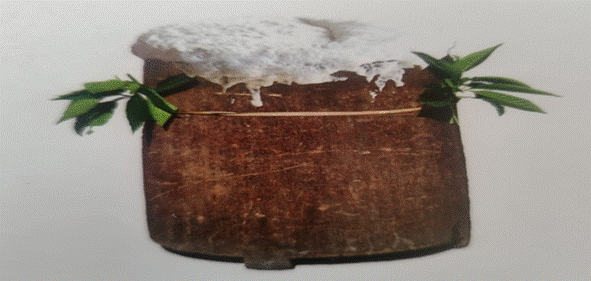
|
Figure 13 Zutse |
2) Leitei: This container is woven with bamboo strips. It can hold liquid due to the unique properties of bamboo and the weaving technique used. It is used to store brews. It has a cylindrical shape with a narrowing mouth at the top. It has a diameter of 40-50 cm and length of 65-80 cm with legs/feet of 10-15 cm height. (Figure 14).
Figure 14

|
Figure 14 Leitei |
3) Thutsherha: This container is also woven with bamboo strips. It is shorter than Leitei and Zutse. It is used to ferment rice brew. It has a diameter of 50-70 cm and height of 30-40 cm with legs/feet of 15-20 cm (Figure 15).
Figure 15
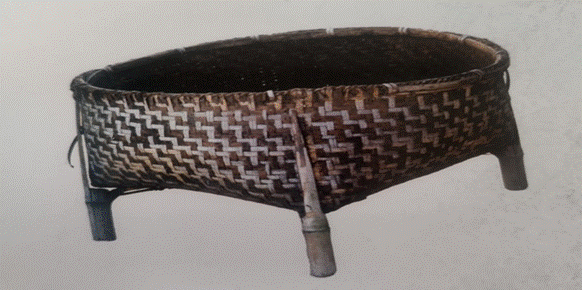
|
Figure 15 Thutsherha |
4) Strainer (Zucharha): This is used in preparation of local brew. It separates the rice particles from the liquid. It is woven with bamboo strips, and is conical in shape (Figure 16).
Figure 16

|
Figure 16 Zucharha |
Other items
1) Gourd (Mesü): This is used for fetching water, and storing brews. It is also used to carry one’s brew to and from the field, and from one place to another. It has a natural way of keeping the brew cool and fresh (Figure 17).
Figure
17

|
Figure 17 Mesü |
2) Baskets (Merha): These baskets or containers are used to store grains, vegetables and other small kitchen items. Merha of different sizes are used for different purposes like measurements, carrying, and storage. These are made of bamboo strips (Figure 18).
Figure 18

|
Figure 18 Merha |
3) Mortar and Pestel (Ciekhe & Kemie): Ciekhe is carved out from tree trunks. It is used to contain and hold grains for pounding. Kemie is made of wood and is used to pound the grains (Figure 19).
Figure 19
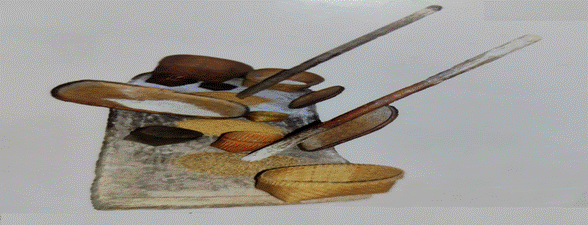
|
Figure 19 Ciekhe & Kemie |
6. Conclusion
Traditional agricultural tools are simple and manual but our forefathers were content with the crops yielded. Traditional indigenous tools of the Angami Naga are lesser to none. They utilise whatever they have and it was sufficient for their survival. With the advancement of technology, agricultural tools have become more advanced and mechanised and have significantly helped reduced labour and also increase agricultural production. These traditional tools can be improved and designed according to the farmers’ requirement by using modern technology. It is intended that this paper may raise interest and inspire more In-depth research in the field.
CONFLICT OF INTERESTS
None.
ACKNOWLEDGMENTS
None.
REFERENCES
Chücha Neichüriezo (2003). Tenyimia Kelhou Dze, Ura Academy.
Pfuchatsumia Mechü Krotho Teicie 25 Nyi- (1990-2015)
Oral
Interview with Rutsa Dzieselhoulie (n.d.). Age 75 years, P. Khel, Kohima Village
Oral
Interview with Sachü Neikuoü (n.d.). Age 59 years, D. Khel, Kohima Village
Oral
Interview with Tseikha Banuo(n.d.). Age 60 years, L. Khel, Kohima Village
Oral
Interview with Zhale Khriesetuoü (n.d.). Age 85 years, Rüsoma Village
Oral
Interview with Suokhrie Seyiechütuo (n.d.). Age 45,
Village Chairman, Chedema Village
 This work is licensed under a: Creative Commons Attribution 4.0 International License
This work is licensed under a: Creative Commons Attribution 4.0 International License
© Granthaalayah 2014-2024. All Rights Reserved.